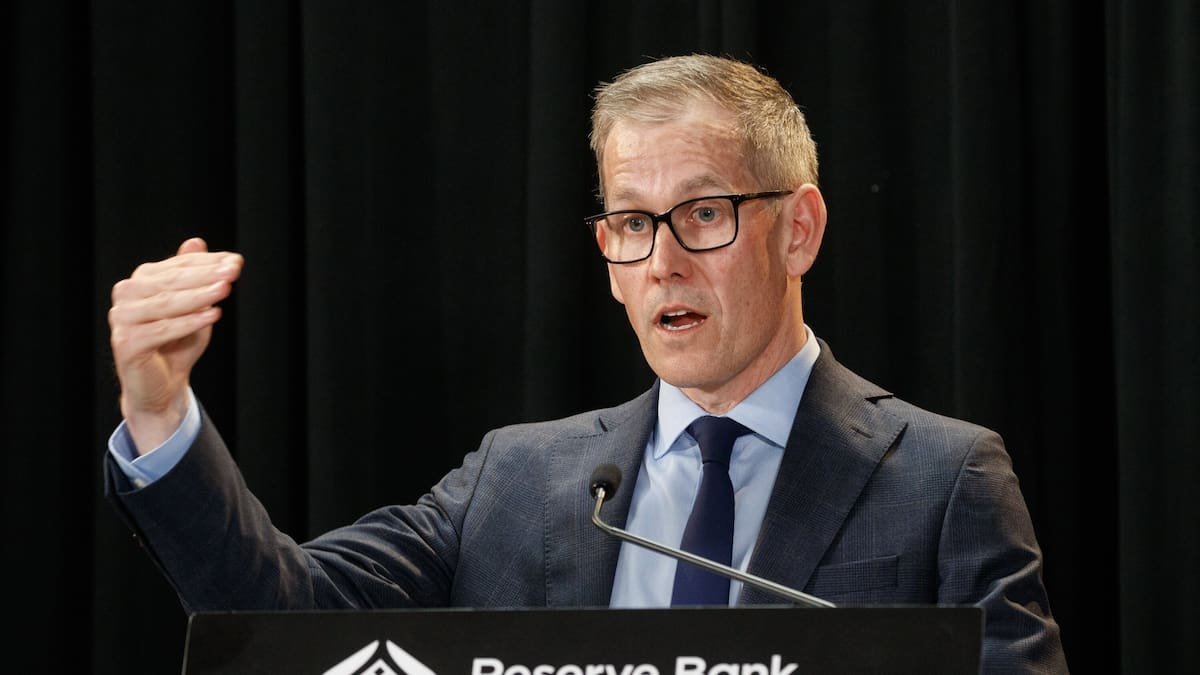The real focus, at 2pm when the Reserve Bank (RBNZ) releases its first full monetary policy statement since February, will be where interest rates are forecast to go over the next year.
Back in February (in that distant reality before United States President Donald Trump shocked the world with his “Liberation Day” tariffs), the RBNZ had forecast a pause at 3.25%, with an even chance of another cut to 3% by the end of the year.
After the tariff shock, the market correction, and subsequent downgrading of expectations for global growth, most economists have assumed the RBNZ will have to cut the rate lower and/or sooner.
ANZ has forecast that it will eventually drop to 2.5%; others are slightly more optimistic, suggesting an endpoint at 2.75%.
But everyone seems very clear that forecasts are contingent on how the unprecedented US policy approach plays out in the coming weeks and months.
There have even been calls for a 50-basis-point cut today.
Wrong call I’m happy I made
In April, I argued that the RBNZ would need to cut by 50 basis points today to get ahead of the curve and save the faltering economic recovery.
At the time, I said I’d be glad to be wrong because that would mean things hadn’t played out as badly as I feared.
They haven’t. I will be wrong, and I am glad.
We’ve seen the US and China go to the brink and pull back. Other big tariff threats – like 50% on European imports – have been delayed. Markets have settled down.
Prices for New Zealand’s key exports have remained high – dairy, beef, and kiwifruit producers are all having a great season.
Unemployment numbers didn’t rise as much as expected. Petrol prices have fallen.
On the flip side, we’ve seen higher grocery food prices potentially pushing inflation back to the upper end of the target band (1-3%).
That will give the RBNZ some pause for thought, even though the sluggish domestic economy means we should see core inflation continue to fall.
I don’t want to overplay the good news.
Big risks remain. The US hasn’t actually reversed its tariff policy. It has just been delayed and softened. We’re still looking at lower levels of economic growth that will hurt our economy.
And there are likely more heart-in-mouth days ahead for investors as Trump continues to take trade negotiations to the brink, as is his style.
Things still don’t feel that flash domestically either. What we are seeing is a two-speed recovery as good exports increase the cashflow and confidence in the rural sector.
It’s the provincial centres, particularly in the south, that are recovering first.
In Auckland and Wellington, things are taking more time. The construction, retail, and hospitality sectors are probably still in recession.
In short, there are still reasons to assume the OCR will head lower than what was expected in February, but given the relative calm right now there is no reason to panic and slash rates.
Multiverse theory
There have been suggestions that, given the uncertainty that US trade policy puts into the outlook, the Reserve Bank may opt not to provide a single rate track.
BNZ head of research Stephen Toplis wrote in April that the RBNZ may need to suspend long-term forecasting, as it did during the peak of Covid uncertainty.
Trump’s tariff policies had “thrown the global central banking community into disarray”, Toplis said.
He noted that the European Central Bank and the Bank of Canada have respectively declined to give forward guidance or forecasts in their latest policy announcements.
Toplis suggested we may see the RBNZ do something similar and put more focus on scenario analysis.
It might be seen by some as a cop-out. But if the multiverse theory is good enough for Marvel movies (and every other sci-fi franchise these days), then why not central banks?
So perhaps we’ll see three different rate tracks produced for three different universes.
One would be for a best-case scenario, where the US and trading partners agree to deals that allow the global recovery to continue at a reasonable pace.
Another would be a mid-case scenario of some high tariffs and trade disruption slowing global growth.
Then there’s always a worst-case scenario, where the deals all fall over and we end up back in a full-blown trade war.
Kiwibank produced three scenarios along these lines and concluded that even a best-case scenario would still see the OCR fall to 2.5%, with 2% for the mid-case and 1.5% for the worst case.
However the RBNZ plays it, you can be sure it’s going to emphasise how uncertain all forecasts are in the current environment.
Hawkesby fronts up
Today marks the first full Monetary Policy Statement (MPS) for the bank, headed by Christian Hawkesby – acting Governor for the next six months or so.
It’s the second OCR decision since Adrian Orr stepped down in March.
Technically, the change at the top shouldn’t make much difference to the decision, as it is made by committee these days, and the committee hasn’t changed since Orr’s departure.
But it will be interesting to watch Hawkesby’s performance at the post-MPS press conference. They’ve been lively under Orr’s tenure with plenty of witty asides and sometimes some tension. Orr wasn’t shy of letting journalists know if he didn’t rate their question.
Hawkesby is a very different sort of character – more reflective and softly spoken.
So we can probably expect a different style of communication from the top.
Is a flat white really more expensive now?
A couple of weeks ago I wrote a column about how soaring dairy prices and coffee prices might create a perfect storm for flat white lovers.
All the public angst seems to be about butter in this dairy price boom, and the latest Selected Price Index inflation data showed it was up 65% in the past year.
But in the same data set, Westpac senior economist Satish Ranchhod noticed that ground coffee prices were up 12% in the past month.
That was a flow-on from a big spike in the commodity price of beans, up about 90% in the past year. Milk prices were up 15% in the year to April.
Intuitively, it feels like the cost of a coffee has gone through the roof in the past few years. I had to ask (because I’m too cheap to buy them these days), but anything from $5-$7 is normal for a flat white, depending on where you’re buying.
But perhaps we’re all suffering a nostalgic bias. As is often the case when it comes to remembering how cheap things used to be, we need to factor in what wages were at the time.
Ranchhod crunched some numbers and found that when you factor in wage growth, coffee was probably more expensive in the 1990s.

“When I was at university in the late 1990s, a flat white cost about $2.50 and the minimum wage was $7,” Ranchhod writes.
“In other words, a cup of coffee cost about one-third of the hourly before-tax minimum wage.”
He recalls that when he started working a few years later in Wellington, a flat white had gone up to $3 and the minimum wage was $8.50.
“Again, a cup of coffee cost about one-third of the hourly minimum wage,” he said.
That ratio held a decade or so later when he was back in Auckland – coffee was $4.50 and the minimum wage was $14.25.
“Now, it’s 2025, and a flat white near my office costs about $5.50 – an increase of about 20% over the past decade.”
“In contrast, the minimum wage has gone up 62% since 2014 to $23.15 [per hour].”
Put differently, the cost of a cup of coffee has not kept pace with increases in wage rates.
So if you’re buying a cup of coffee, it’s more affordable compared to wages, he concludes.
Budget win
It didn’t make the headlines like the KiwiSaver changes and the capital depreciation tax break, but a relatively small increase in funding for Stats NZ may have an outsized impact on the economy.
Following calls from the Reserve Bank (and this column) for Stats NZ to be funded to produce more macroeconomic data in a more timely fashion, the Government has done just that.
It has allocated $62 million over the next four years to deliver “eight updated macroeconomic measures” by the end of 2030.
Perhaps even more importantly, Stats NZ has been given $16m more in funding to begin work on producing Consumers Price Index inflation data on a monthly basis.
Both initiatives are supposed to be ready to roll in 2027.
Having to work with quarterly inflation data was a source of much frustration during the post-Covid years and made it much harder for the Reserve Bank to pick the exact point at which inflation started to spike, started to peak and began to fall.
On that basis (although we’ll never know for sure), the delay may have contributed to interest rates going up later than they needed to and staying higher for longer than they needed.
If it did, then it may have cost the economy hundreds of millions, or even billions, of dollars.
Seems like the Government gets it and even at a time of tightening budgets has recognised the value of investing in more timely measurement of our economic status. Well done.
Liam Dann is business editor-at-large for the New Zealand Herald. He is a senior writer and columnist, and also presents and produces videos and podcasts. He joined the Herald in 2003. To sign up to his weekly newsletter, click on your user profile at nzherald.co.nz and select “My newsletters”. For a step-by-step guide, click here. If you have a burning question about the quirks or intricacies of economics send it to liam.dann@nzherald.co.nz or leave a message in the comments section.





